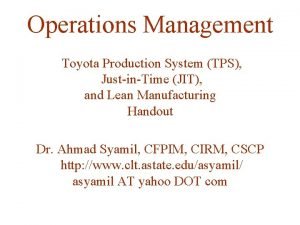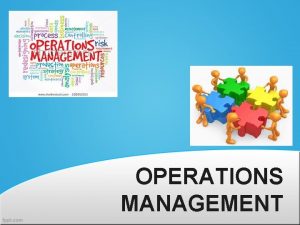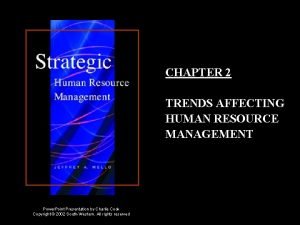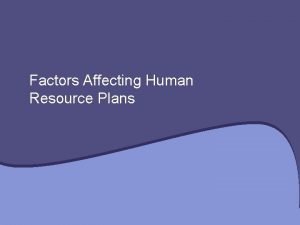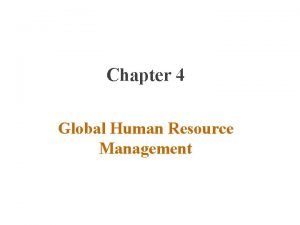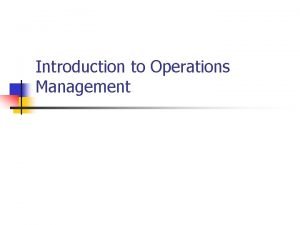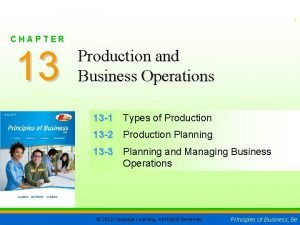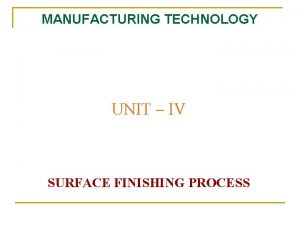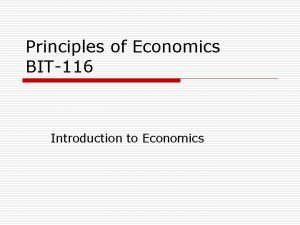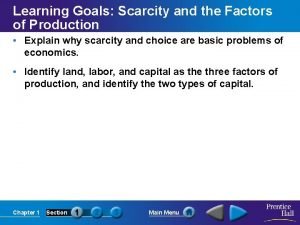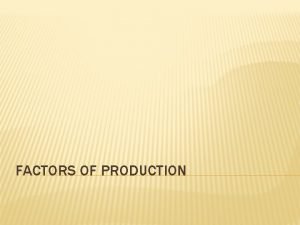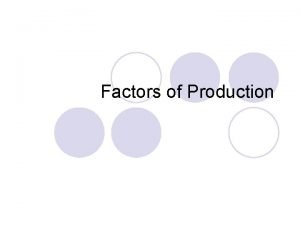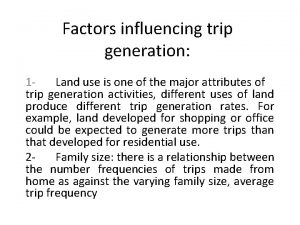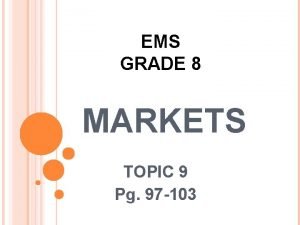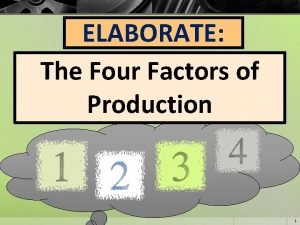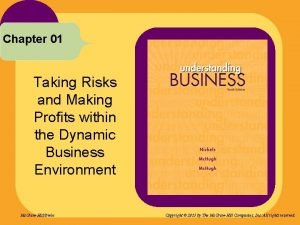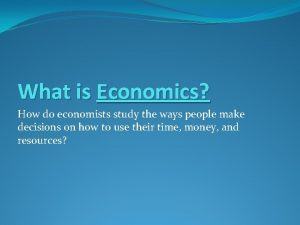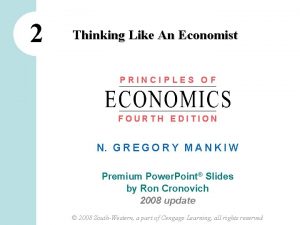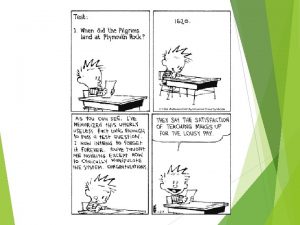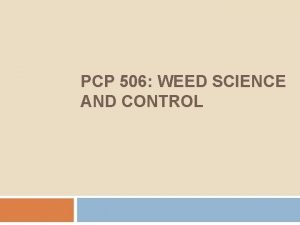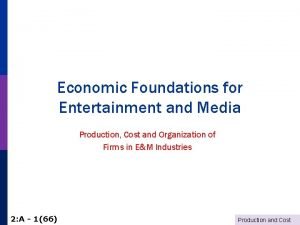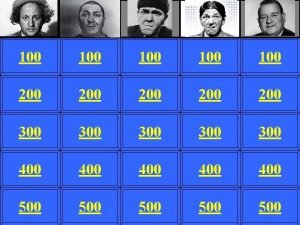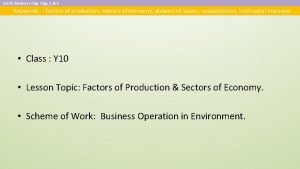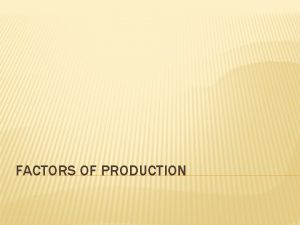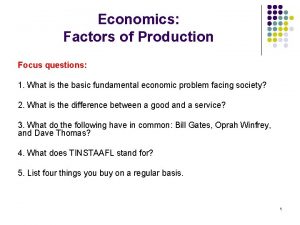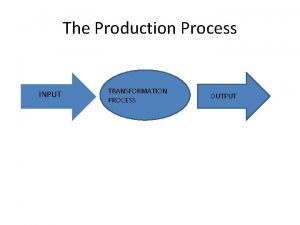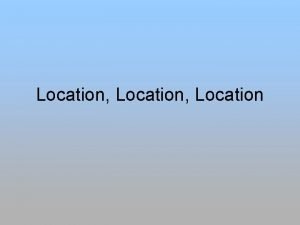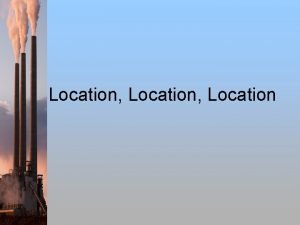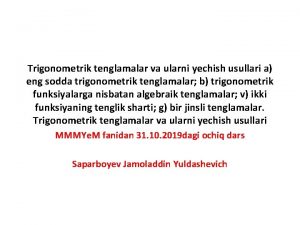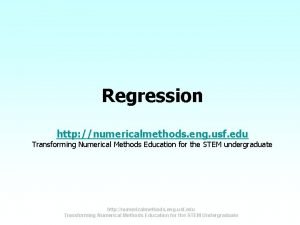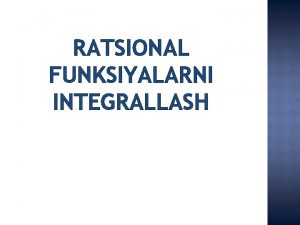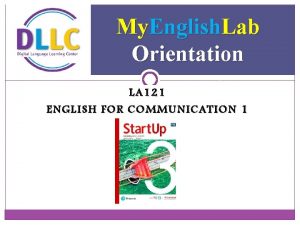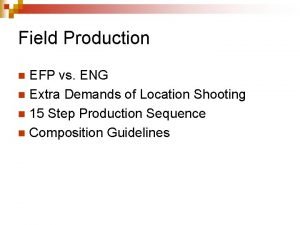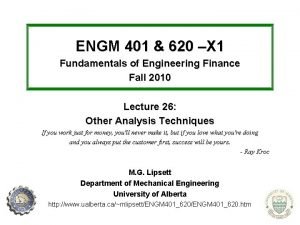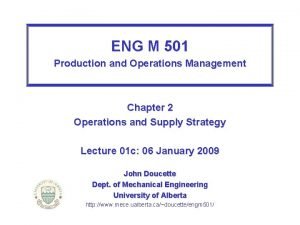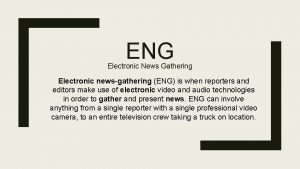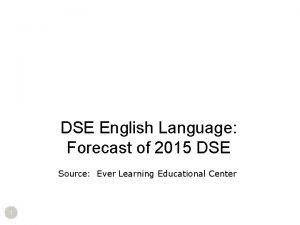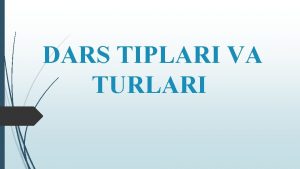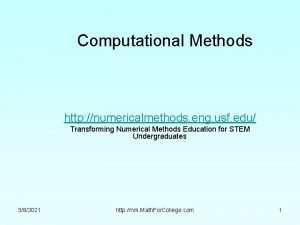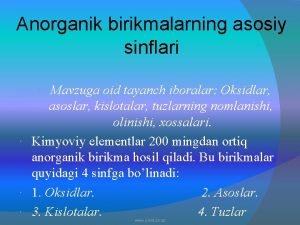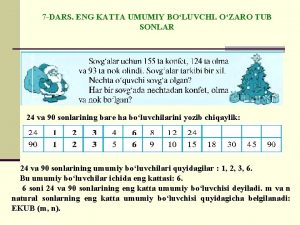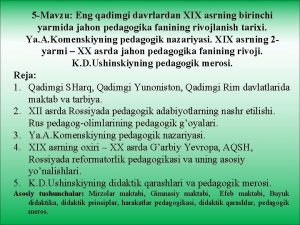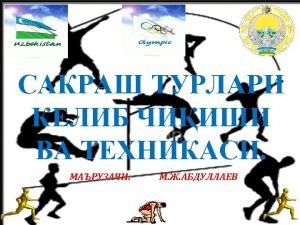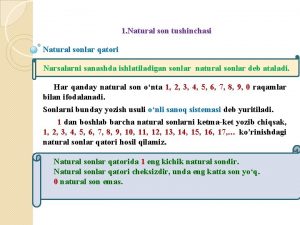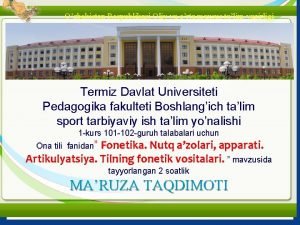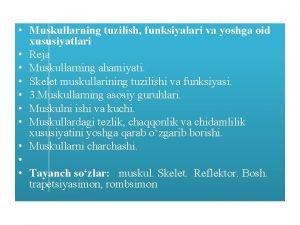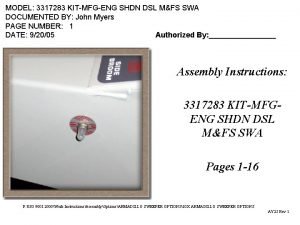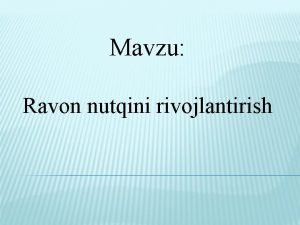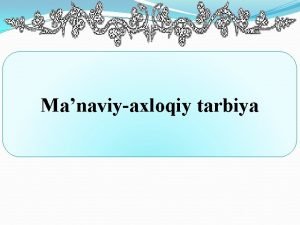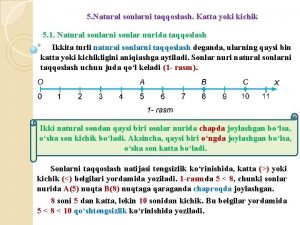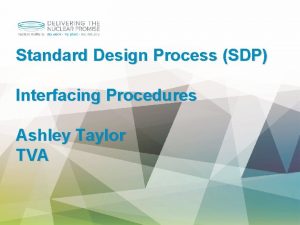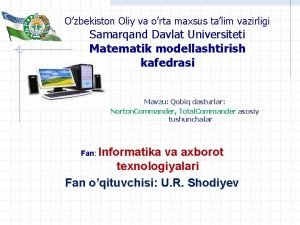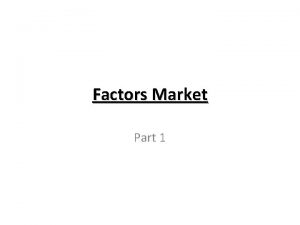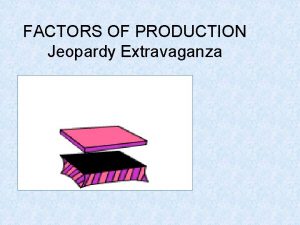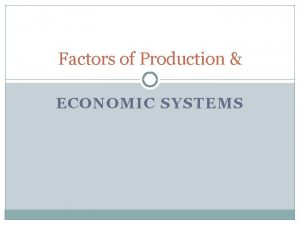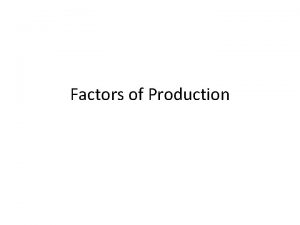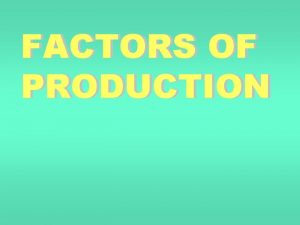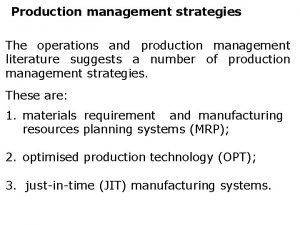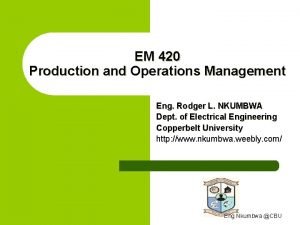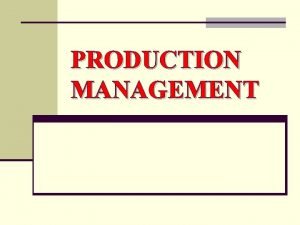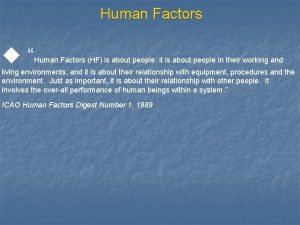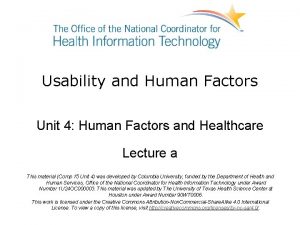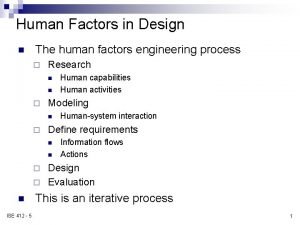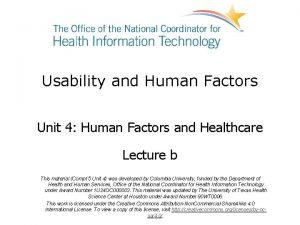Human Factors in Production Operations Management Sir Eng


















































































- Slides: 82

Human Factors in Production & Operations Management Sir Eng R. L. Nkumbwa™ www. nkumbwa. weebly. com © 2010 Nkumbwa™. All Rights Reserved. 1

Outline 1. 2. 3. 4. 5. 6. Ergonomics Knowledge Management Rewards & Recognition Safety & Health Effective Teams Conducting Effective Meetings © 2010 Nkumbwa™. All Rights Reserved. 2

Ergonomics © 2010 Nkumbwa™. All Rights Reserved. 3

WHAT IS ERGONOMICS? - It is the practice of arranging the environment to fit the person working in it. - Ergonomic principles help reduce the risk of potential injuries from : * Overuse of muscles * Bad Posture * Repetitive motion - Objective of ergonomics is to accommodate workers through the design of: * Tasks * Controls * Tools * Work stations * Displays * Lighting & equipment © 2010 Nkumbwa™. All Rights Reserved. 4

WHY IS THERE A CONCERN? - Recognition that risks exist within the workplace, both in the factory and office areas. - Commitment to providing a “Clean, Safe and Attractive” work environment for employees. - Benefits from Safety improvements create the same for Productivity and Quality of product. - Regulatory requirements (OSHA). © 2010 Nkumbwa™. All Rights Reserved. 5

WHAT MAKES AN EFFECTIVE PROGRAM? - Management commitment and employee involvement are essential. - Management can provide: * Resources ( Time, people, financial ) * Managing & motivating forces behind effort - Employees can provide: * Intimate knowledge of the jobs performed * Identification of existing & potential hazards - Together they provide the solutions to the issues. © 2010 Nkumbwa™. All Rights Reserved. 6

RELATED DISORDERS/INJURIES - Musculo-skeletal system of the body is affected. - Illnesses affect the structure of the body: * Muscles * Nerves * Tendons * Joints * Ligaments * Bones * Supporting body tissue - Injuries are disorders of the: * Back * Neck * Upper/lower extremities * Shoulders * Strains, sprains, tissue inflammation & dislocation © 2010 Nkumbwa™. All Rights Reserved. 7

DISORDERS/INJURIES CONTINUED Cumulative Trauma Disorders - Can affect nearly all tissues, nerves, tendons & muscles. - Upper extremities most affected. - Develop gradually from repeated forceful actions. Carpal Tunnel Syndrome - Affects the hands and wrists. - Develops due to repeated or forceful manual tasks. Back Disorders - Pulled or strained muscles, ligaments, tendons & disks. - Most disorders result from long term injury. - Excessive or repetitive twisting, bending or lifting. © 2010 Nkumbwa™. All Rights Reserved. 8

CAUSES & CONTRIBUTING FACTORS SHORT TERM INJURIES/Acute exposures: - Identifiable accident or trauma caused injury LONG TERM INJURIES/Chronic exposures - Problems builds over time, no specific accident source UNSAFE CONDITIONS - Weight of object - Size & shape - Height of work - Housekeeping © 2010 Nkumbwa™. All Rights Reserved. UNSAFE ACTIONS - Improper lifting/lowering - Twisting with a load - Excessive reaching - Lifting beyond capacity 9

HAZARD PREVENTION & CONTROL ENGINEERING CONTROLS - Eliminate the task or unnecessary movement. - Reduce weights of loads, increase handling capacity of equipment. - Workspace modifications. - Use handles or “easy grip” surfaces. - Investigate quality problems that may cause stresses. - Lift properly, keeping loads close to body. - Logical, convenient controls and displays. © 2010 Nkumbwa™. All Rights Reserved. 10

HAZARD PREVENTION & CONTROL CONTINUED ADMINISTRATIVE & PROCESS CONTROLS - Work rest or break scheduling. - Training in proper lifting techniques & ergonomics. - Job orientation, training and follow up. - Rotation between high & low stress tasks. - Housekeeping. - Video study and evaluation of job tasks. - Use of effective job safety analysis program. - Enforcement of existing procedures. © 2010 Nkumbwa™. All Rights Reserved. 11

ERGONOMIC MODIFICATION PROCESS 1) Identify existing or potential problems - Analyze injury data - Interview staff & employees - Observe work activity - Conduct initial ergonomic evaluation 2) Identify & evaluate risk factors involved. 3) Review data, info. with Management and employees. 4) Design & implement corrective measures. 5) Monitor & evaluate effectiveness of corrective measures. © 2010 Nkumbwa™. All Rights Reserved. 12

INTERVENTION DESIGN CONSIDERATIONS 1) Task, Job and Workplace Factors 2) Employee Factors 3) Process / Human Interface 4) Management and Supervision Styles © 2010 Nkumbwa™. All Rights Reserved. 13

RISK FACTORS WORK ENVIROMENT - Temperature & humidity - Air velocity - Lighting & glare - Noise levels Work Station - Working heights - Reaching, awkward postures - Workplace & workpiece access - Furniture, floor surfaces © 2010 Nkumbwa™. All Rights Reserved. 14

RISK FACTORS CONTINUED TOOLS & EQUIPMENT - Vibration - Hand posture, grip & grasp - Hand pressure & forces - Tool design, condition & maintenance - Controls & displays (layout, function) MATERIALS & CONTAINERS - Lifting/Lowering - Twisting/turning - Pushing/pulling - Grip & grasp - Repetitive motions - Size, weight, handles, edges © 2010 Nkumbwa™. All Rights Reserved. 15

RISK FACTORS CONTINUED HUMAN FACTORS - Static body postures - Body size & strength - Body movements - Workload - Handling methods - Employee condition & motivation © 2010 Nkumbwa™. All Rights Reserved. 16

WORK PRACTICE CONTROLS The key elements of an effective work practice program are: - Instruction in proper work techniques. - Employee training & conditioning. - Regular monitoring. - Feedback. - Adjustments. - Modification. - Maintenance. © 2010 Nkumbwa™. All Rights Reserved. 17

WORK AT WORKING SAFELY Awareness of ergonomics and the causes of related disorders is critical in prevention efforts: - Cooperate with employer in making related design changes in the workplace. - Be aware of signs & symptoms indicating a possible problem or injury caused by poor workplace design. - Participate in hazard controls initiated by employer. - Be aware of job-specific techniques used to alleviate ergonomic issues. - Follow doctor’s instructions, if under treatment. © 2010 Nkumbwa™. All Rights Reserved. 18

Knowledge Management © 2010 Nkumbwa™. All Rights Reserved. 19

Why Knowledge Management? Knowledge is: Knowledge results in: v The cutting edge of organizational success (Nonaka, 1991) v The “learning organization” (Mayo & v The engine transforming global economies (Bell, 1973, 1978) v The “brain-based organization” v Leading us toward a new type of work with new types of workers v Intellectual capital” (Stewart, 1994) (Blackler, Reed and Whitaker, 1993) v The element that will lead to the demise of private enterprise capitalism (Heilbruner, 1976) v The sum total of value-added in an enterprise (Peters, 1993) v The “mobile and heterogeneous [resource that will end the] hegemony of financial capital [and allow employees to] seize power” Lank, 1995) (Harari, 1994) v “Learning partnerships” (Lorange, 1995) v Obsolete capitalists economies and radically different societies (Drucker, 1993) Conclusion Knowledge is fast becoming a primary factor of production (e. g. , Handy, 1989, 1994; Peter, 1993; Drucker, 1992) (Sveiby & Lloyd, 1987) © 2010 Nkumbwa™. All Rights Reserved. Source: Theseus International Management Institute, February 2000 20

What is Knowledge Management What is knowledge management? “Knowledge management is leveraging relevant intellectual assets to enhance organizational performance. ” Stankosky, 2002 © 2010 Nkumbwa™. All Rights Reserved. 21

KM Pays Off—True KM Implementation and Results • Dow Chemical: $100 m • Silicon Graphics: $2. 8 m • Texas Instruments: $500 m (cost avoidance) • Computer Sciences Corp: $5. 8 b • Chevron: $150 m • Cemex: (average delivery time 20 minutes) • Ford: 3 month reduction in cycle time • Cisco: One hour virtual financial close © 2010 Nkumbwa™. All Rights Reserved. 22

Process Efficiency Effectiveness Input Output Business Strategy KM Starts with the Business Strategy g lin in s Bu na b te rp En • Business Process / Best Practices • Capabilities People s er ris iv Dr e. E s es Implementation / Operational Plans • Value Added • Environmental Influences Processes Technology Infrastructure Management and Maintenance LEADERSHIP ORGANIZATION © 2010 Nkumbwa™. All Rights Reserved. TECHNOLOGY LEARNING 23 Baldanza, 1999

Barriers to Knowledge Management Success Results From International Survey: v Organizational Culture 80% v Lack of Ownership 64% v Info/Comms Technology 55% v Non-Standardized Processes 53% v Organizational Structure 54% v Top Management Commitment 46% v Rewards / Recognition 46% v Individual vice Team Emphasis 45% v Staff Turnover 30% © 2010 Nkumbwa™. All Rights Reserved. Earnst & Young KM International Survey, 1996 (431 senior executive responses) 24

Key Elements to Engineering a KM System Theory: A formulation of apparent relationships or underlying principles of certain observed phenomena which has been verified to some degree. Webster’s New World Dictionary © 2010 Nkumbwa™. All Rights Reserved. 25

Knowledge Management Engineering - Overview SYSTEMS APPROACH INPUT SYSTEMS THINKING SYSTEMS ANALYSIS PROCESS SYSTEMS MANAGEMENT OUTPUT SYSTEMS ENGINEERING / BPR INFORMATION SYSTEMS ENGINEERING AND MANAGEMENT KNOWLEDGE MANAGEMENT ENGINEERING THE ENTERPRISE INTEGRATIVE MANAGEMENT / ENGINEERING KNOWLEDGE MANAGEMENT INFRASTRUCTURE © 2010 Nkumbwa™. All Rights Reserved. 26

Knowledge Engineering, Integration, and Management FEEDBACK INPUTS © 2010 Nkumbwa™. All Rights Reserved. FEEDBACK PROCESS OUTPUTS 27 Stankosky 2001

Summary v Embodies a theory for knowledge management, with validated key elements as design inputs v Enterprise-wide approach in the design of a knowledge management system v Systems’ perspective throughout the various phases of system design v Integrates both integrative management and systems engineering disciplines into a single construct to ensure successful design, implementation, and management of a knowledge management system. If taking a true systems approach, a knowledge management system will enhance efficiency, effectiveness, and innovation through leveraging its enterprise’s intellectual assets. © 2010 Nkumbwa™. All Rights Reserved. 28

Rewards & Recognition © 2010 Nkumbwa™. All Rights Reserved. 29

Rewards & Recognition Seven steps for a rewards and recognition system 1. Develop a rewards and recognition strategy. • Starting with the organization’s priorities and values, determine the behaviors you want to recognize (these are your strategic objectives) and the strategic initiatives you may need to take within each facet of your pride and recognition program. © 2010 Nkumbwa™. All Rights Reserved. 30

Rewards & Recognition Seven steps for a rewards and recognition system 2. Review your formal awards. • You may need to make adjustments to the awards programs you already have to ensure they support your strategic objectives. © 2010 Nkumbwa™. All Rights Reserved. 31

Rewards & Recognition Seven steps for a rewards and recognition system 3. Align your informal awards. • Your informal awards also need to reinforce your overall directions and values. The key here is to customize your informal awards to fit your culture and employees. © 2010 Nkumbwa™. All Rights Reserved. 32

Rewards & Recognition Seven steps for a rewards and recognition system 4. Determine the reinforcing day-to-day managerial behaviors. • What we are looking at here is ‘walking the talk’. The management team at all levels needs to be aware of how their day-to-day decisions and actions affect employees’ behavior. Organizational health surveys and other feedback mechanisms may assist managers in gaining this understanding and in making adjustments where required. © 2010 Nkumbwa™. All Rights Reserved. 33

Rewards & Recognition Seven steps for a rewards and recognition system 5. Align other management systems. • Consider whether other systems such as performance management, training, resource allocation and staffing support your pride and recognition strategy and program. © 2010 Nkumbwa™. All Rights Reserved. 34

Rewards & Recognition Seven steps for a rewards and recognition system 6. Establish a feedback system. • An on-going approach to monitoring and improving the program will ensure it continues to promote the changing culture and directions of your organization. You might consider integrating reward and recognition indicators with financial and other performance measures. © 2010 Nkumbwa™. All Rights Reserved. 35

Rewards & Recognition Seven steps for a rewards and recognition system 7. Market the program. • Bring attention to your activities, not only within your organization, but also to other departments and external agencies and associations. © 2010 Nkumbwa™. All Rights Reserved. 36

Safety & Health © 2010 Nkumbwa™. All Rights Reserved. 37

Why Worry about Safety? n Why do you need to be concerned about safety? W C Loss Pain! EPA $$$$ Lost time © 2010 Nkumbwa™. All Rights Reserved. Hu rt DOL 38

Why Worry: Common Reasons n Getting hurt isn’t fun!!! © 2010 Nkumbwa™. All Rights Reserved. 39

Not All Pain is Gain Nobody likes getting hurt. Healthy employees are more productive employees. © 2010 Nkumbwa™. All Rights Reserved. 40

Why Worry: Common Reasons n n Getting hurt isn’t fun!!! Cost of Accidents © 2010 Nkumbwa™. All Rights Reserved. 41

Cost of Accidents n n Direct Costs n Medical Costs (including worker’s comp) n Indemnity Payments Indirect costs n Time Lost (by worker and supervisor) n Schedule delays n Training new employees n Cleanup time / equipment repairs n Legal fees © 2010 Nkumbwa™. All Rights Reserved. 42

Cost of Accidents: The Iceberg Effect On average, the indirect costs of accidents exceed the direct costs by a 4: 1 ratio © 2010 Nkumbwa™. All Rights Reserved. 43

Why Worry: Common Reasons n n n Getting hurt isn’t fun!!! Cost of Accidents Legal Issues and Liability © 2010 Nkumbwa™. All Rights Reserved. 44

Legal Issues and Liability n As a result of safety violations: n You can be named in a law suit n Criminal charges may be filed against you n You can be cited by an enforcement agency n You can be fined by an enforcement agency n Your lab/workplace can be shut down by an enforcement agency © 2010 Nkumbwa™. All Rights Reserved. 45

Legal Issues and Liability n Because of personal liability, and you can be named as a defendant in a lawsuit n Working for a company does not protect you. © 2010 Nkumbwa™. All Rights Reserved. 46

Legal Issues and Liability n © 2010 Nkumbwa™. All Rights Reserved. You can have criminal charges filed against you. n Negligent supervisors and employers have been charged with manslaughter 47

Legal Issues and Liability n You can be cited by an enforcement agency n State Department of Labor (DOL) n n EPA n n DOL is currently inspecting departments on campus They’ve already been here, and they’re coming back! Federal OSHA has authority to get involved n GM plant in OKC © 2010 Nkumbwa™. All Rights Reserved. 48

Legal Issues and Liability n You can be fined by an enforcement agency n State DOL will issue citations first n EPA will levy fines… n n n Boston University was fined $750, 000 in 1997 Brown University was fined $500, 000 in 2000 University of Hawaii was fined $1. 7 million in December © 2010 Nkumbwa™. All Rights Reserved. 49

Legal Issues and Liability n Cease and desist orders: if the violations are serious enough, agencies such as DOL, OSHA, and the EPA can (and will) shut down the job site until the problems are corrected. © 2010 Nkumbwa™. All Rights Reserved. 50

So how do you protect yourself? ? ? ? ? © 2010 Nkumbwa™. All Rights Reserved. 51

Understanding Accident Causes n Accidents are caused by: n Unsafe acts n Unsafe conditions © 2010 Nkumbwa™. All Rights Reserved. 52

Accident Causes n Unsafe Conditions n Easiest to correct (and very cost effective) n Easiest to prevent n n n Safety audits Safety inspections Maintenance schedules for equipment Encouraging employee reporting Good housekeeping © 2010 Nkumbwa™. All Rights Reserved. 53

Accident Causes n Unsafe Acts n Most difficult to address n n Changing behavior isn’t easy Best prevented by developing a “safety culture” © 2010 Nkumbwa™. All Rights Reserved. 54

Safety Cultures n n Establish accountability for safety Define safety responsibilities © 2010 Nkumbwa™. All Rights Reserved. 55

Establishing Accountability: Performance Evaluations n n Employees should be evaluated on their safety performance n Doing a job correctly includes doing it safely Job description revisions may include generic job descriptions with: n “Must follow all general and safety policies and procedures as established by the department, college/division, and university. ” © 2010 Nkumbwa™. All Rights Reserved. 56

Establishing Accountability n n Charge back systems Safety goals n Accident costs n n n Equipment damage Lost time Accident rates n n First aid #s Workers comp #s Loss ratios (including automobile rates) Safety Activities n Safety meetings, inspections, using PPE n n © 2010 Nkumbwa™. All Rights Reserved. 57

Defining Responsibilities n Employee responsibilities include: n Recognizing safety hazards n Reporting safety hazards n Maintaining good housekeeping n Working safely n Using personal protective equipment (PPE) n Making the most of safety training © 2010 Nkumbwa™. All Rights Reserved. 58

Defining Responsibilities n Employer responsibilities include: n Providing access to information n Haz Com - MSDSs, written program Bloodborne Pathogens – written program Lab Safety – chemical hygiene plan © 2010 Nkumbwa™. All Rights Reserved. 59

Defining Responsibilities n Employer responsibilities (cont. ) n Providing personal protective equipment n From OSHA 1910. 132: “Protective equipment, including personal protective equipment for eyes, face, head, and extremities, protective clothing, respiratory devices, and protective shields and barriers, shall be provided, used, and maintained in a sanitary and reliable condition wherever it is necessary by reason of hazards of processes or environment, chemical hazards, radiological hazards, or mechanical irritants encountered in a manner capable of causing injury or impairment in the function of any part of the body through absorption, inhalation or physical contact. ” © 2010 Nkumbwa™. All Rights Reserved. 60

Defining Responsibilities n Employer responsibilities (cont. ) n Providing training n n n Hazard Communications n Annual & within first 30 days of employment, also when new hazards are introduced Quarterly safety training (required by state) Special programs n Laboratory n Bloodborne pathogens n Respirators n Forklifts © 2010 Nkumbwa™. All Rights Reserved. 61

Defining Responsibilities n Employer responsibilities (cont. ) n OSHA General Duty Clause: “Each employer n n Has the general duty to furnish each employee with employment and places of employment free from recognized hazards causing or likely to cause death or serious physical harm. The specific duty of complying with safety and health standards promulgated under the act. ” © 2010 Nkumbwa™. All Rights Reserved. 62

So what does all this mean? n It means that safety is everybody’s business. From the moral aspect to the legal aspect, we all benefit from a safe work environment. © 2010 Nkumbwa™. All Rights Reserved. 63

Effective Teams © 2010 Nkumbwa™. All Rights Reserved. 64

Your Organization Can Benefit from Teams n Team output usually exceeds individual output. n Complex problems can be solved more effectively. n Creative ideas usually are stimulated in the presence of other individuals who have the same focus, passion, and excitement. n Teams both appreciate and take advantage of diversity. n Support arises among team members. © 2010 Nkumbwa™. All Rights Reserved. 65

The Importance of Creating High Performance Teams n Characteristics of High Performing Teams n Small Size n Complimentary Skills n Common Purpose n Specific Goals n Mutual Accountability © 2010 Nkumbwa™. All Rights Reserved. 66

The Five Stages of Team Development n n n Forming Storming Norming Performing Adjourning © 2010 Nkumbwa™. All Rights Reserved. 67

Variations in Productivity and Morale during Team Development © 2010 Nkumbwa™. All Rights Reserved. 68

Adapting Leadership Style to Facilitate Team Development n n Provide Direction – focus is on the task; getting the job done n Identifying purpose, setting rules, identifying goals and performance standards Provide Support - focus is on inter-relationships; how the team works together n Developing harmony, cohesion, participation and listening, praising © 2010 Nkumbwa™. All Rights Reserved. 69

Adapting Leadership Style to Facilitate Team Development n n Structuring Resolving Collaborating Validating © 2010 Nkumbwa™. All Rights Reserved. 70

Leadership Style © 2010 Nkumbwa™. All Rights Reserved. 71

Leadership Style and Team Development © 2010 Nkumbwa™. All Rights Reserved. 72

Some hints to get through these stages n n Forming: n Be clear on your purpose and problem n Agree on ground rules for meetings and behaviours n Set goals and timetables, assign tasks Storming: n Encourage different points of view about the project n Break down the project into small parts and seek small successes © 2010 Nkumbwa™. All Rights Reserved. 73

Some hints to get through these stages n n Norming: n Move from being directive to being supportive n Challenge the group to analyze and resolve personal disagreements n Stick to your goals and timetables Performing: n Encourage everyone in the team to be equal members n Have lots of regular communication © 2010 Nkumbwa™. All Rights Reserved. 74

Transforming Existing Work Groups into High Performing Teams n Assessing and Solving Problems to Team Effectiveness n n Lateness and absenteeism at meetings, negative gossip, not helping others Problem Awareness: Determining Symptoms of Ineffective Teams n Over Dependency on the Leader n Unrealized Decisions n Hidden Conflicts n Fighting without Resolution n Subgroups © 2010 Nkumbwa™. All Rights Reserved. 75

Transforming Existing Work Groups into High Performing Teams n Problem Identification n Weak Sense of Direction n Infighting n Shirking of Responsibilities n Lack of Trust n Critical Skills Gaps n Lack of External Support © 2010 Nkumbwa™. All Rights Reserved. 76

Team Discussion n Using previous information and other personal sources (i. e. your brain), create a specific strategy you might use to overcome the following group problem: n One member of the team is not putting in their share of the work and is missing meetings © 2010 Nkumbwa™. All Rights Reserved. 77

Conducting Effective Meetings © 2010 Nkumbwa™. All Rights Reserved. 78

Conducting Effective Meetings n Preparing for the Meeting n Set Objectives – problems to solve, issues to address, decisions to be made n n n Select Participants Set a Time and Place Plan the Agenda Distribute the Agenda and Relevant Materials in Advance Consult with Participants Before the Meeting © 2010 Nkumbwa™. All Rights Reserved. 79

Conducting Effective Meetings n Conducting the Meeting n Begin the Meeting with the Agenda n Establish Specific Time Parameters n Control the Discussion n Use Problem Solving Techniques n Encourage and Support Participation by All Members © 2010 Nkumbwa™. All Rights Reserved. 80

Conducting Effective Meetings n Conducting the Meeting n Encourage the Clash of Ideas, but Discourage the Clash of Personalities n Exhibit Effective Listening Skills n Reach a Consensus n End the Meeting by Clarifying What Happens Next © 2010 Nkumbwa™. All Rights Reserved. 81

Conducting Effective Meetings n Follow Up after the Meeting n Spend the Last Five Minutes Debriefing the Meeting Process. n The Best Time to Share Your Reactions to the Meeting Is Right After It Has Ended n Brief Memo Summarizing Discussions, Decisions, and Commitments (minutes) © 2010 Nkumbwa™. All Rights Reserved. 82
 Funksiyaning ekstremumlari
Funksiyaning ekstremumlari Production post production pre production
Production post production pre production Takt time toyota production system
Takt time toyota production system Introduction to production management
Introduction to production management Product design process in operations management
Product design process in operations management Job expansion in operations management
Job expansion in operations management Factors affecting human resource management
Factors affecting human resource management Factors affecting human resource management
Factors affecting human resource management Factors affecting global human resource management
Factors affecting global human resource management Production management definition
Production management definition Chapter 13 study guide production and business operations
Chapter 13 study guide production and business operations Surface finishing operations in production technology
Surface finishing operations in production technology Quality management in operations management
Quality management in operations management Operations management chapter 12 inventory management
Operations management chapter 12 inventory management Operations management with total quality management book
Operations management with total quality management book Economics definition
Economics definition Factors of production
Factors of production Factors of production
Factors of production Where are goods produced
Where are goods produced Who are they
Who are they Factors influencing trip attraction
Factors influencing trip attraction Types of markets in ems
Types of markets in ems 5 factors of production
5 factors of production Chapter 18 the markets for the factors of production
Chapter 18 the markets for the factors of production 5 factors of production
5 factors of production Four factors of production
Four factors of production Four factors of production
Four factors of production Four factors of production
Four factors of production Allelospoly
Allelospoly Cost of factors of production
Cost of factors of production Forced common ownership of factors of production
Forced common ownership of factors of production Labor resource examples
Labor resource examples 4 factors of production
4 factors of production Factors of production pictures
Factors of production pictures Factors of production pictures
Factors of production pictures List the factors of production
List the factors of production Factors of production for shoes
Factors of production for shoes Input-transformation-output model examples
Input-transformation-output model examples Site vs situation
Site vs situation Abiotic and abiotic factors
Abiotic and abiotic factors Abiotic vs biotic factors
Abiotic vs biotic factors Abiotic factors and biotic factors
Abiotic factors and biotic factors Biotic v abiotic
Biotic v abiotic Location situation
Location situation 8-1 factors and greatest common factors
8-1 factors and greatest common factors Common factors of 10 and 20
Common factors of 10 and 20 Factos of 8
Factos of 8 Time management in human resource management
Time management in human resource management Types of retail organization structure
Types of retail organization structure Literal sense in hrm
Literal sense in hrm Trigonometrik tenglamalar
Trigonometrik tenglamalar Http://numericalmethods.eng.usf.edu
Http://numericalmethods.eng.usf.edu Ratsional kasr funksiyalarni integrallash
Ratsional kasr funksiyalarni integrallash Eng efp camera
Eng efp camera เฉลย my english lab startup 5
เฉลย my english lab startup 5 Sinab
Sinab Pedagogika qanday fan
Pedagogika qanday fan Dse eng weighting
Dse eng weighting Edexcel gcse english language paper 2
Edexcel gcse english language paper 2 Eng vs efp
Eng vs efp Eng m 401
Eng m 401 Eng m 501
Eng m 501 Electronic news gathering process
Electronic news gathering process Dse 2015 eng
Dse 2015 eng Aralash dars turi
Aralash dars turi Http://numericalmethods.eng.usf.edu
Http://numericalmethods.eng.usf.edu Avesto
Avesto Anorganik birikmalarning eng muhim sinflari
Anorganik birikmalarning eng muhim sinflari Tub bo'luvchilar soni
Tub bo'luvchilar soni Jahon pedagogika fanining rivojlanish tarixi ppt
Jahon pedagogika fanining rivojlanish tarixi ppt Turgan joyda uzunlikka sakrash
Turgan joyda uzunlikka sakrash Eng kichik natural son
Eng kichik natural son Engineering notation
Engineering notation Bir tovush bilan farq qiladigan so'zlardan 10 ta yozing
Bir tovush bilan farq qiladigan so'zlardan 10 ta yozing Muskullarning ishi
Muskullarning ishi Eng shdn
Eng shdn Til va nutq markazi
Til va nutq markazi Oila tarbiyasi metod shakl va vositalari
Oila tarbiyasi metod shakl va vositalari Heerlijk klonk het lied der eng'len lyrics
Heerlijk klonk het lied der eng'len lyrics Sonlar nuri nima
Sonlar nuri nima Jismning
Jismning Ip-eng-001
Ip-eng-001 Axborot nima
Axborot nima


